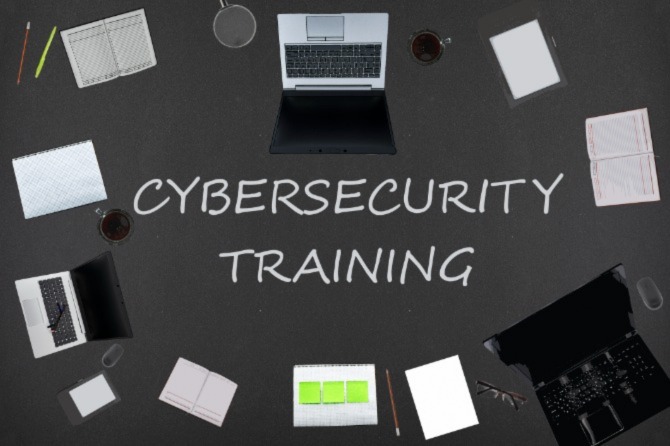
Cybercrime is an increasing risk for individuals and businesses alike. As both the volume and complexity of cyber attacks increases, the need for cyber awareness and cybersecurity training has never been greater. Cybersecurity training is not just for IT staff – anyone who uses technology is a potential target for cybercriminals and would therefore benefit from training and awareness.
What is cybersecurity training?
Often, the best way to learn cybersecurity is through training. Organizations carry out cyber awareness and cybersecurity training to help staff members develop their knowledge of best practices to keep sensitive data secure. Typically, cybersecurity training teaches response procedures for addressing and managing risk to computer systems. Participants can learn how to identify threats like cyber attacks, data hacks and phishing activities, how to assess risk levels, how to report incidents, and how they can be addressed.
Cybersecurity training is a vital component of cybersecurity workforce preparation – bringing learners up to speed with the current threat landscape. Some organizations may also use cybersecurity training to support policy development regarding cybersecurity practices.
What does cybersecurity training cover?
Rapid changes in the digital environment – and parallel innovations by cybercriminals – mean that employees and other end users need consistent training on how to stay safe online and how to protect their information.
Cyber awareness and cybersecurity training often includes:
- Phishing attacks – how to spot them and how to report them
- Removable media – how to use them safely
- Passwords and authentication – how to create strong passwords and how to implement multi-factor authentication
- Physical security – how to ensure the safety of physical devices and documents
- Mobile security – how to use mobile devices safely and securely
- Working remotely – how to stay safe when working remotely, including the risks of public Wi-Fi
- Cloud security – guiding employees through the secure use of cloud-based applications
- Social engineering – the most common techniques malicious actors use and the influence of psychology
- Data and record management – how to monitor and manage company data securely
- Installation protocols – how to install third party applications and software programs safely on company computers
- Alert response procedures – for addressing and managing risks to computer systems
- Compliance – understanding the regulatory environment for your industry and jurisdiction and what this may mean for cybersecurity
For those who wish to pursue a career in cybersecurity, training will depend on what career path the person takes. Cybersecurity professionals work in organizations of all sizes, across different industries, and in networks of all complexities.
Why is cybersecurity training important?
It’s estimated that 95% of cybersecurity breaches are the result of human error. A business’s digital security is in the hands of every employee, whether they work in IT or not. Some common mistakes employees make that compromise digital security are:
- Downloading malware-infected email attachments.
- Visiting untrustworthy websites.
- Using weak passwords.
- Not updating passwords regularly.
- Accidentally sending an email to the wrong recipient.
Given the scope for human error, cyber awareness and cybersecurity training are critical. The benefits of cybersecurity training include:
Reducing the risk of data breaches and phishing attacks
Raising cyber awareness within an organization can help to reduce the risk of data breaches. Once individuals are trained to spot potential risks and how to overcome them, they are less likely to fall victim to attacks such as phishing. Given the average cost of data breaches can run into millions, cybersecurity training is cost effective by comparison.
Building a culture of security
The primary purpose of cybersecurity training is to instil a culture of security within an organization. A culture of security means embedding security values into the fabric of the company – making people the first line of defense against threats like social engineering.
Increasing technological defences against cyber threats
Technological defences are a valuable weapon in preventing breaches – but they require human input. For example, firewalls need to be turned on, software needs to be updated, and security warnings need to be acknowledged. Few organizations would operate without technological defenses and yet, without cybersecurity training and cyber awareness for staff, there is a risk that technological defenses can’t fulfil their potential.
Providing reassurance to customers
Consumers are increasingly aware of cyberthreats and as a consequence, want to feel safe and secure. This means businesses need to take cybersecurity seriously so they can generate customer trust. In turn, customer trust will help to ensure customer loyalty. If a company experiences a data breach or security incident, and it becomes public knowledge, it can cause reputational damage.
Complying with regulations
Depending on both sector and jurisdiction, there may be regulatory reasons that require organizations to take cybersecurity seriously. Regulators can require specific industries to implement cybersecurity awareness training. Compliance shouldn’t be the sole reason an organization provides cybersecurity training – but introducing the right training makes an organisation more secure and, in many sectors, is a regulatory requirement.
Demonstrating corporate and social responsibility
Cyber attacks can spread quickly. The more networks that become infected, the more risk other networks become exposed to. One network’s weakness increases the overall threat for others. This means that a lack of security awareness training in one organisation makes other organisations vulnerable. Ultimately, security awareness training doesn’t just benefit individual organizations – it benefits their customers, suppliers, and any other entity interlinked with their network.

Key elements of cybersecurity
There are several key elements to cybersecurity. These are:
- Application security
- Information security
- Disaster recovery planning
- Network security
- End-user security
- Operational Security
Each of these elements represents a different area of an organization’s infrastructure, which requires its own protection.
Application security
Application security focuses on protecting software applications from threats. This applies especially to companies that develop and sell their applications and cloud services, but also to businesses more generally.
Security settings which are not configured properly are a significant cause of cloud account data breaches. Companies can sometimes use a major cloud service without realizing that they need to customize their security settings from defaults.
The main causes of cloud application misconfiguration are:
- Lack of awareness of cloud security policies
- Lack of adequate controls and oversight
- Too many interfaces to manage effectively
- Negligent insider behaviour (i.e. user error)
Actions such as setting up multi-factor authentication and administration privilege controls are key aspects of cyber awareness which help to strengthen application security and prevent apps from being breached.
Information security
Information security refers to the protection of company data and the data collected from customers, clients, or vendors.
Most organizations will need to adhere to information security standards – with penalties for non-compliance if negligence leads to personally identifiable information being compromised.
Cybersecurity focuses on how organizations collect, store, and transmit data. A cybersecurity plan aims to put protections in place to ensure that data is encrypted as needed and protected from being breached.
Disaster recovery planning
60% of small businesses fold after falling victim to a cyber attack. To avoid being included in this statistic, it’s important for companies to have a disaster recovery plan in place.
Disaster recovery protections typically include:
- Strategies for preventing a breach or malware infection
- Preparations for rapid recovery once an attack has taken place
Measures that a cyber security expert will put in place include a backup and recovery system, incident response drills, and strong endpoint protection.
Network security
Network security aims to protect an organization’s physical network and all the devices connected to it. Most companies use firewalls to monitor incoming and outgoing traffic for threats.
Other key aspects of network security include securing the wireless network and ensuring any remote connections take place through encrypted methods.
Network security is designed to ensure that only authorized users gain access to the network, and that no suspicious behaviours are happening inside the network that would indicate a breach.
End user security
End user security, or endpoint security, refers to protecting the devices that users work with, and users themselves. Given the high proportion of cyber attacks which start with a phishing email, end user security is essential.
Common types of end-user protection include:
- Keeping devices updated
- Using up-to-date antivirus software
- DNS filtering to block malicious websites
- Firmware protection to prevent breaches at the firmware layer
- Passcode-protected screen locks
- Remote management and device detection
Organizations which don’t practice end user security could suffer a breach through an unprotected employee device that becomes infected with malware and then spreads that infection throughout the company network.
Aside from device protection, cybersecurity awareness training is a core aspect of end user security. It’s good practice to provide regular training to employees on topics such as detecting phishing emails, password security, handling sensitive data, and other cyber hygiene principles.
Operational security
Operational security involves reviewing an organization’s entire security strategy as a whole to ensure that all security tactics are working together – and not in conflict – throughout operations.
Operational security is the umbrella that covers all IT security processes. It ensures that the organization is not only securing all areas of a potential breach, but also regularly updating its security strategies to keep up with the latest threats and security advances. Part of this process involves thinking like an attacker – examining the different areas of a technology environment to identify where a potential breach could occur.

How to get started in cybersecurity
Many careers in cybersecurity start in entry-level IT roles, such as help desk technicians, network administrators, or software developers. Many cybersecurity professionals start their careers as a junior information security analyst after gaining some experience in IT.
Before starting a cybersecurity role, it’s important to develop some core IT skills, such as programming, networks and systems administration, and cloud computing. It’s generally agreed that some form of structured training can accelerate your path towards obtaining a job.
Career paths within cybersecurity
A career in cybersecurity can take different directions, depending on a person’s interests and goals. Here are some of the ways a cybersecurity analyst can specialize:
Engineering and architecture
Security engineers use their knowledge of threats and vulnerabilities to build and implement defense systems against a range of security concerns. Security engineers may advance to become security architects, responsible for an organization’s entire security infrastructure. Skills for this role include:
- Critical thinking
- IT networking
- System administration
- Risk assessment
Incident response
Despite significant efforts to ensure cybersecurity, organizations can still fall victim to security incidents. The field of incident response focuses on what steps are required after a security incident takes place. Incident responders monitor their organization’s network and work to fix vulnerabilities and minimize losses when breaches occur.
Incident response also involves digital forensics and cybercrime. Digital forensic investigators work with law enforcement to recover data from digital devices and investigate cybercrimes. Skills for this role include:
- Technical writing and documentation
- Intrusion detection tools
- Forensics software
- Attention to detail
Management and administration
Cybersecurity managers oversee an organization’s network and computer security systems. These tend to be roles for those with more experience. A cybersecurity manager might manage security teams, coordinate between teams, and ensure security compliance. Typically, the highest security role in an organization is Chief Information Security Officer (CISO). Working in security at an executive level often means managing operations, policies, and budgets across the company’s security infrastructure. Skills for this role include:
- Project management
- Risk management
- Leadership
- Collaboration
Consulting
Organizations hire security consultants to test computer and network systems for vulnerabilities or security risks. In this role, you will practice cybersecurity offense and defense by testing systems for vulnerabilities and making recommendations on how to strengthen those systems. Skills for this role include:
- Penetration and vulnerability testing
- Threat management
- Operating systems
Testing and hacking
This field of cybersecurity is known by various names, including offensive security, red team, white hat hacking, and ethical hacking. (You can read more about different types of hacking here.) People who work in offensive security take a proactive approach to cybersecurity. They do this by playing the part of the intruder, trying to identify vulnerabilities before real hackers do. Penetration testers seek to identify and exploit system weaknesses to help companies build more secure systems. Ethical hackers try out even more attack vectors (like social engineering) to reveal security weaknesses. Skills for this role include:
- Cryptography
- Penetration testing
- Computer networking
- Scripting
Types of cyber attacks
A non-exhaustive list of cyber attacks is:
- Phishing: This involves sending fraudulent emails pretending to be from a reputable source. The intention is to steal sensitive information like login or payment details.
- Malware: Malicious software which attempts to gain unauthorized access and damage a computer or network.
- Ransomware: Similar to malware, but the intention is to block access to files on a computer until the victim pays a ransom.
- DDoS: Distributed denial of service attack, in which the cybercriminal overwhelms a system’s resources so that it does not function properly.
- Structured Query Language (SQL) injection attack: This takes place on a database-driven website when the hacker manipulates a standard SQL query. It is carried out by injecting a malicious code into a vulnerable website search box, therefore forcing the server to reveal crucial information.
- Cryptojacking: This involves attackers accessing someone else’s computer for mining cryptocurrency.
- Zero-day exploits: These involve attackers taking advantage of a security vulnerability which is known about but not yet patched.
- Insider threats: A threat which does not involve a third party but an insider. This could be an individual from within the organization with extensive knowledge about the organization. Insider threats have the potential to cause significant damage.
Cybersecurity Awareness Month
In the US, since 2004, the President and Congress have declared October to be Cybersecurity Awareness Month. The aim of this month is to help people protect themselves online as cyber threats become more widespread. In the US, the Cybersecurity and Infrastructure Security Agency (CISA) and the National Cybersecurity Alliance (NCA) work collaboratively with government and industry to raise cybersecurity awareness both in the US and around the world.
Best practice responses to cyber attacks
How should businesses respond to a cyber attack? Here is a step-by-step guide:
Step 1: Engage a response team
Once an attack is identified, the first thing an organization should do is secure their IT infrastructure as quickly as possible and mobilize a cybersecurity response team. The team’s first task is to identify the source of the attack and its cause. Depending on the resources of the organization, this team may be an internal one or it may be a third party. The important thing is to move quickly and start work while the evidence is still fresh.
Step 2: Determine the type of attack
Identifying the type of cyber attack allows the cybersecurity response team to carry out the appropriate measures. Knowing what type of attack is occurring enables you to focus resources effectively so you can contain and recover from the attack.
Step 3: Contain the threat
Once the type of attack has been identified and confirmed, the next step is preventing the threat from causing further damage. Most passive attacks are designed to provide the attackers with a persistent backdoor into an organization’s systems, so that data can continue to be extracted over time. For this reason, it’s important to identify and shut down all access the attackers may have to your system.
Step 4: Notify relevant authorities
Depending on the scale and nature of the attack, you may need to report the incident to local law enforcement. The earlier they are notified, the more they can do to help. Depending on your industry and jurisdiction, there may be certain agencies or industry bodies you need to notify too. If you carry cyber insurance, then you should contact your insurance provider as soon as possible.
Step 5: Communicate with affected parties
If the attack has impacted customer data, you need to let your customers know. It’s important to be as upfront and transparent as possible about what has taken place. If other businesses you work with have also been affected, then you need to communicate with them. Cyber attacks can result in major reputational damage, so it’s advisable to work with a public relations specialist to determine the best way to handle communications and manage the PR impact of the incident.
Cybersecurity training courses
How to learn cybersecurity? Cybersecurity training can help. With a constantly evolving threat landscape, it’s vital that IT security specialists as well as other teams within an organization keep their skills up to date. Kaspersky offers online employee training which teaches effective threat detection and mitigation strategies.
These courses can be done from the comfort of your own home and are authored by experts who understand how to handle the threats posed by the 350,000+ malware samples they encounter every day, and how to share that knowledge with those doing battle with the evolving dangers of today’s cyber reality.
So whether you're an InfoSec professional aiming to advance your skills or a team manager looking to invest in your SOC and incident response team, these courses can help. Find out more about our online cybersecurity training for experts here.
Further reading:


